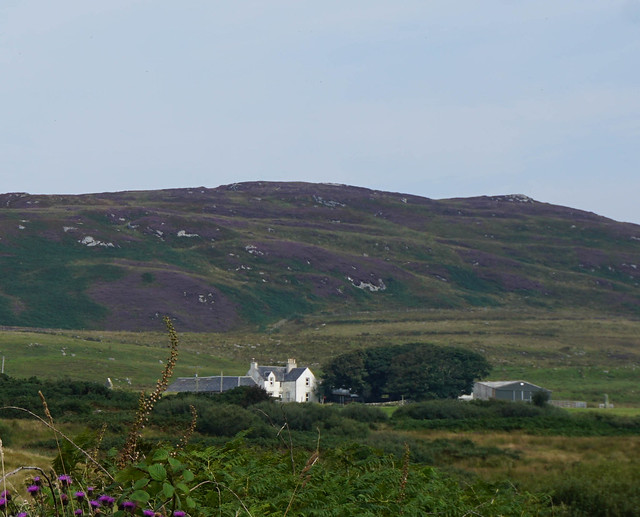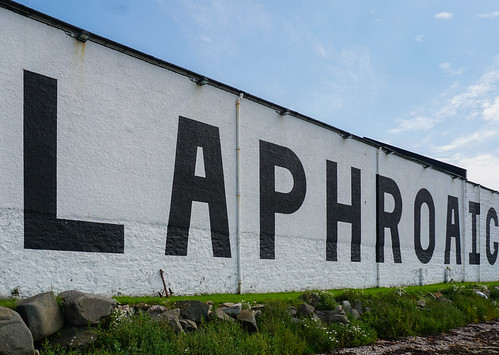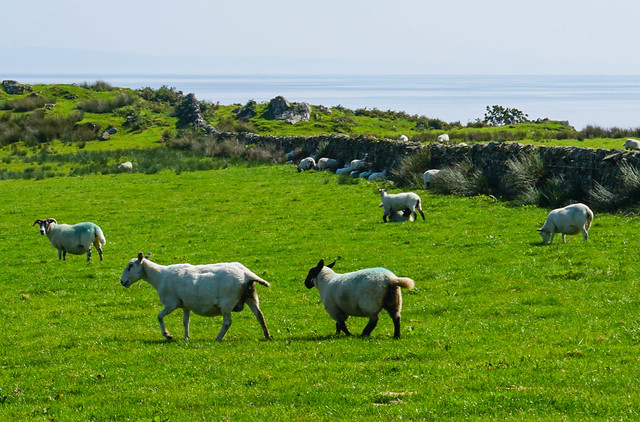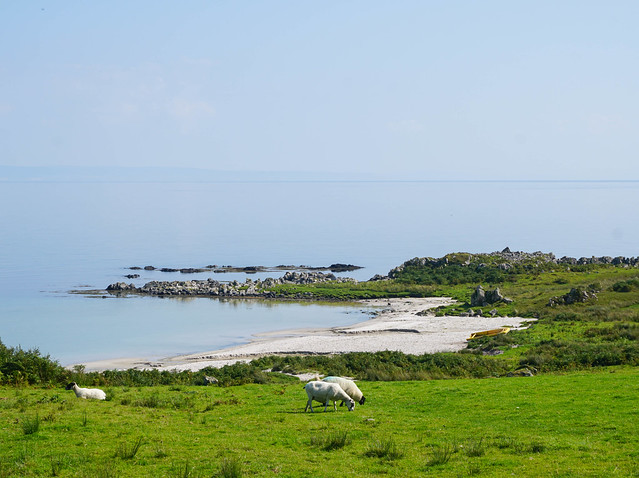But last night was this rule's exception. Restless. Ate too much? Change in the air?
Up at night, I look out over the waters. A light in the middle of the bay, shimmering.
And then, just as the night recedes, I look out again. Still there. Plainly visible now. A fishing boat in the calm night.

Out my other window, the street lights are still on. The slate roofs, gray blue skies, white walls made golden along the path of the street lamps.

Restless nights bring with them their own rewards.
Breakfast. At the bay window again. Back to salmon and eggs.

Today I'll go to that part of the island that is the main draw for most who come here: the rugged southeastern coast that is home to the three major distilleries (Laphroaig, Lagavulin and Ardbeg) -- the ones I see (if I'm lucky) on the flight into Islay.
As I drive out of Bowmore, I note the preschool children with their mothers or grandmothers... I think about Snowdrop and her day and how different it is from the day of an island child. (Not better, not worse, just very different.)

As I drive up that more well traveled road to the distilleries, I see that here, too, the heather spreads its prickly branches across the hills.

But I don't go into those hills just yet. I have a small agenda. First stop is the whisky drinker's perhaps most beloved distillery -- Laphroaig. (Not that the other whiskys are less favored; Laphroaig, at 2.7 million liter capacity, is just that much bigger than the others -- Lagavulin at 2.25 million, Ardbeg at 1.1 million, Bowmore at 2 million liters) and so it has a larger following.

I want to find out if this year's release (the peaty and dark Lore) is available in the US. They think it is, or at least will be. No need to buy it then. But I do something else while here. Andrew, my innkeeper, suggested I might want to become a Laphroaig friend (he is one). You can do that: in registering as such, you get your own designated square foot of peat. And you get to collect rent on it: a small bottle of 10 year old. All this costs you nothing. It's just a way of creating community among Laphroaig's followers.
Here I am with my "certificate of ownership."

Alright. I move on to my next stop -- Ardbeg Distillery.

I like to learn a little bit more about this island's whisky business each time I am here and so inevitably, I am drawn to some tour or special visit. There is a lot to choose from, as each distillery has organized visits, often theme based, always quite small and therefore intimate.
This year, Ardbeg added a new tour (I like to think of it as more of a tutorial) called "whisky and wood." Andrew suggested that I try it as no one knows much about it and it's likely to be less in demand.
He is right: I am the only one on the tour and so I get my own guide for about an hour -- a woman who has been with Ardbeg for only three years, but who has lived her whole life in Port Ellen (just three miles down the coast).

The focus is on what happens after the whisky is already made: where does it go? Most people acknowledge that the components of production (ingredients, peat smoke, quality of water, etc etc), while important, are only the first step in the making of a quality whisky. Resting the whisky in barrels imparts the flavors we find so appealing.

And so I learn about the barrels. Always oak (American -- younger, smaller, or European -- older larger), charred or toasted --giving that smokey taste and the whiff of vanillin.
There is at Ardbeg the first fill -- always Bourbon casks from Kentucky. And then all hell breaks loose and you start to play. The second fill may be to another bourbon cask.
Why take it out of a bourbon cask and put it right back into another bourbon cask? I ask
My guide has great patience for such novice questions: because of course (!) it picks up more of the bourbon soaked wood's properties.
Or the refill will be to a sherry cask from Spain. Or a wine cask from France. Maturation (by the sea, always with the breeze of the sea not too far off) of an Islay single malt in these barrels gives the sought after taste of a fine Islay whisky.
My tutorial includes a lesson in what exactly a barrel does to the flavor of a whisky and so I get samples of three -- a pure 1999 first fill bourbon (which is never sold), a second -- a refill to a bourbon cask, and a third -- a refill to a sherry cask.
And these are matched for me with foods: I'm told that the smokiness of the firstfill bourbon would go nicely with smoked mussels. I'm given a sample of mussels to judge for myself.
The second, a 12 year old bourbon refill is softer. I'm given a smoky Isle of Mull cheddar to eat alongside the whisky.
And finally, the third pairs so well with dark chocolate and I am given a sample of chocolates from Oban made for the distillery: dark with a salty caramel filling. Fantastic with the sherry casked whisky!
Of course, that's a lot of whisky to sample (and there are some more samples to be had of their limited editions) and so I come prepared. Andrew has these sets of tiny bottles which you can take with you (especially those of us who are driving). From the drams you get on the tours, you sample just enough to get the first tiny taste and you pour the rest into the wee bottles to take home so that you're not drinking and driving afterwards at the same time that these exquisite whiskies do not go to waste. It's a clever idea and I have five tiny bottles in my pack to show for it.
But again I buy nothing. I agonize over this: the Ardbeg festival bottle (Dark Cove) is just the whisky I'd have in my store, to pour for any visitor to the farmhouse who loves or is intrigued by whisky from the Scottish isles. But they tell me it can be had in the U.S. And so why pack it here? (One reason is that it's extremely hard to obtain in the States, but in my mind, that's not a good enough reason. If you really want it, you can get it.)
I leave with only my tiny five bottles and, perhaps more importantly, with a really satisfying feeling of knowing just that little bit more about the craft of whisky making.
I don't return yet to Bowmore. I want to do one last hike on the island. It's very close to Ardbeg: the main road ends at the distillery, but you can follow a single track (yet again!) up north for five miles more and when you cannot drive another inch (because even the pretense of a road ends), you can walk up over the hill and to the coast.
And here's where the skies really open up. The air is still and very warm. They say it's only in the mid sixties F, but it seems much warmer than that. The sun is out. It feels, for the first time that I am on Islay, like it's summer.
(Here's the last mile of the "road." As usual, your eyes must be glued to the bend to make sure there is no car coming straight at you.)

Alright. The "road" ends at a farmstead. I get out and open the gate to the pastureland (as always, crossing a farmer's field is allowed, expected, welcomed).
Sheep stare...

Sheep, take care!

Ewes with blues...

And then I leave the farm and follow the "trail" over to the hills, which are beautifully covered with heather!

It really is a sight to behold, with great reverence and respect for the beauty of the landscape, unmarked by human hand.

Well now, but this virtue spells doom for the casual hiker. Unmarked. Indeed!
Yes, I have my stick, Alison's wellies, my emergency pack with phone even though there are no signals here. But these are not enough. Very quickly I come to understand why this hike is rated as "most difficult."
The path goes up one hill, down the next. But am I even on a path? What's deer track and what's my path? Which way to return?
And the bog! Patches of turf and heather help keep me out of the deepest mud holes. But there are burns (aka small streams) making their way to the sea and sometimes you don't even know you've come across one until your boot goes that much lower into the wet ground.
The air is still. Warm. I've long ago shed my sweater.
I'm thinking -- enough. I've reached the last summit of this walk. I can see the shore below. Take the photo and head back.

Doing a time release photo on the soggy heather covered turf is a challenge. But I get one in!

Slowly, with many mistakes, I find my way back.
I am very relieved to be at the farmstead again, where the walking is heavenly, easy, and the breeze picks up from the sea...
Ewes in twos...



Yes, smug, tickled, and satisfied until I look down on my hand and find the first tell tale sign of a tick.
Do you know about the Scottish tick? It's tiny! I mean, smaller than a pin ball. I remember this all too well from camping in Scotland with Ed. Trying to pick out ticks at the end of the day in the tent with a flashlight was a challenge I do not look forward to ever again.
By the car, I take seriously the challenge of finding all the ticks before I get in. (They are almost all on my hands and bare arms. And, of course, on my clothing, so I take care to brush these off for a first solid de-ticking before heading home.)
The drive back has two very special moments. One is just at the beginning: in the hills, a flock of game birds traverses the field. I think they're grouse, but I'm not sure. It will be a topic of discussion in the breakfast room the next day.
No, not corncrakes, they don't travel in packs. So... grouse after all?

And another special scene, almost escaping the reach of my camera -- the iconic red deer of Islay.

And now I am ready to drive back, past the distilleries again, through Port Ellen...

To Bowmore and my guest house, where I do another even more thorough tick check, take a hot shower and soak my clothes for a long while in the sink.
Sometimes it feels grand to just be in the quiet corner of one's own room. Especially when the views are this good!

I eat a quick supper at the Lochside. Broccoli soup, pan roasted salmon. It's the kind of place that reminds you of throwing a dinner together at home: uncomplicated, fresh.
And in my room again, I glance out to see the sun do yet another brilliant descent. Behind clouds. Except in moments when it peeks through for a final wave.


